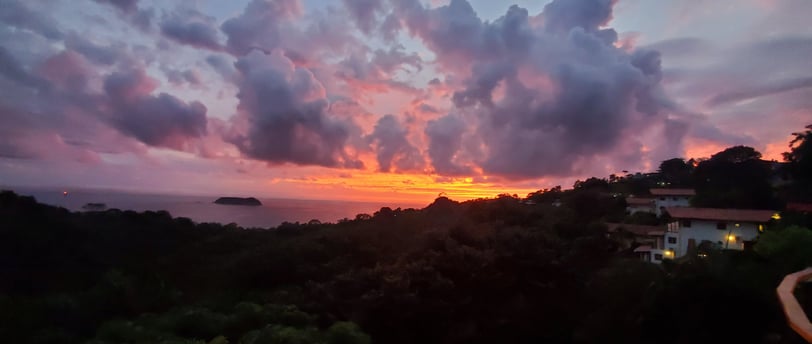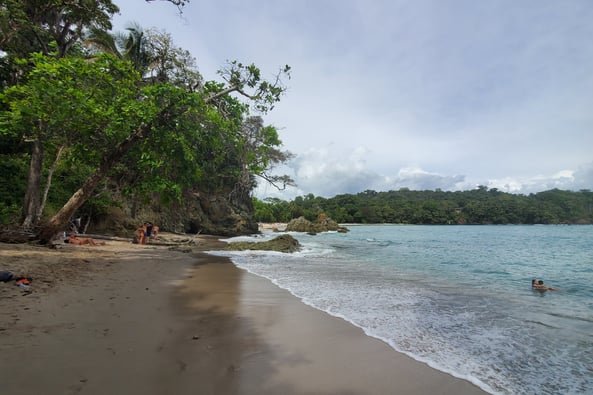Costa Rica Overview for First-Time Visitors: A True Tico Perspective
Thinking of visiting Costa Rica? This blog is the perfect introduction to the country’s main destinations and what to expect in each one. From iconic spots like Arenal Volcano and Monteverde Cloud Forest to the remote beauty of the Osa Peninsula, you'll discover the best places to visit and experiences you can't miss. Plus, find answers to frequently asked questions about costs, transportation, safety, and travel tips to help you plan an unforgettable adventure.
Daniel Alvarez


Costa Rica, thanks to its proximity to the US, is an excellent destination to visit. I had the blessing of growing up in this beautiful country, and in this blog, I want to give you an overview of what to expect when you visit. I’ll also answer some of the most frequently asked questions (FAQs) at the end to help you plan your trip.
My goal is to help you discover which part of the country will best suit your future vacation based on the activities available in each region.
Some History About Costa Rica
Located in the heart of the Americas, Costa Rica is a small nation that punches above its weight on the world stage. Though relatively small roughly the size of West Virginia this country boasts an astounding level of biodiversity, hosting nearly 6% of the world's species within its borders.
Costa Rica’s history is equally remarkable. Unlike many of its neighbors, Costa Rica has enjoyed a long-standing democracy and, uniquely, abolished its army in 1949. The resources previously allocated to the military were redirected toward education and healthcare, highlighting the country's commitment to peace. From its pre-Columbian indigenous roots to its coffee driven economic growth and pioneering ecotourism initiatives, Costa Rica offers a captivating blend of natural wonder and rich history. You'll find a nation proud of its Pura Vida philosophy a way of life that emphasizes simple pleasures, well-being, and a deep connection to nature.
Main Areas of the Country
Despite its small size, Costa Rica is incredibly diverse! For first-time visitors, here are some key regions worth exploring, each offering a unique experience:
Pro Tip: Focus on just a couple of areas for your first visit. This will minimize travel time and allow you to fully enjoy each destination without feeling rushed.
Papagayo
The Papagayo Peninsula is synonymous with refined beauty and tranquility, located in the Guanacaste province on Costa Rica's northern Pacific coast. When I think of Papagayo, the word that comes to mind is "exclusive." It's a place where nature is not just present it's meticulously curated and celebrated within a setting of understated luxury.
Unlike some of the more rugged or bohemian beach towns in Costa Rica, Papagayo offers a sophisticated escape. It’s where the rainforest meets the ocean in the most elegant way, allowing visitors to feel pampered while being surrounded by Costa Rica’s incredible wildlife and landscapes. This region is perfect for travelers seeking a high-end experience deeply connected to the natural wonders of our Pura Vida paradise.
Key Highlights:
Luxury Resorts: Home to many high-end resorts offering world-class amenities. You’ll find some of the most luxurious hotels and resorts in this area.
Outdoor Activities: Hiking in Rincon de la Vieja National Park, horseback riding, ziplining, and water sports such as snorkeling and scuba diving.
Proximity to Liberia: Close to Liberia International Airport, making it easily accessible.
Rich Marine Life: Bahia Culebra, at the heart of Papagayo, is a protected bay teeming with marine life.
Tamarindo
Also located in the Guanacaste province, Tamarindo is arguably Costa Rica's most well-known beach town especially popular for its sun, surf, and lively atmosphere. For years, Tamarindo has drawn travelers from around the world with its consistent waves and golden beaches.
I remember my first visit to Tamarindo a while ago; it already had a rustic buzz about it. Returning now feels like seeing an old friend who’s become incredibly popular and successful. While the town has become more polished and international, its core charm remains the beautiful beach and breathtaking sunsets. It’s a testament to Tamarindo’s enduring appeal, even as it evolves.
Key Highlights:
Surfing for Everyone: Tamarindo is famous for its surf spots and caters to all levels, from gentle waves perfect for beginners right in front of town to more challenging breaks nearby for experienced surfers.
Long Sandy Beach: Expansive and beautiful, perfect for sunbathing, beach volleyball, or simply relaxing and watching the waves roll in.
Lively Town Atmosphere: A bustling town, especially in the evenings, with a wide range of restaurants from casual beachside eateries to upscale dining along with shops, bars, and a social, energetic vibe.
Sunset Views: Tamarindo Bay faces west, making it perfect for sunset views. Watching the sun dip into the Pacific is a daily ritual and a breathtaking sight.
Proximity to Nature & Activities: Despite its development, Tamarindo remains close to Costa Rica’s natural wonders. You can take boat trips, estuary tours, and day trips to nearby national parks, striking a balance between relaxation and adventure.
Manuel Antonio
Situated on the Central Pacific coast, Manuel Antonio is a popular destination known for its stunning blend of rainforest and beaches. It’s celebrated for its rich biodiversity and easily accessible natural beauty. Here, you can find accommodations for all budgets from hostels to luxury properties. This area has so much to offer and is personally one of my favorite spots in the country.
Key Highlights:
Manuel Antonio National Park: Despite being Costa Rica’s smallest national park, it’s incredibly biodiverse and home to monkeys, sloths, iguanas, and numerous bird species. The park also features beautiful beaches like Playa Manuel Antonio and Espadilla Sur.
Beaches: A variety of beaches, both inside and outside the national park, perfect for swimming, sunbathing, and surfing. Espadilla Beach is particularly popular for surf lessons.
Sportfishing: Nearby Quepos is known for world-class sportfishing, especially from the renowned Marina Pez Vela.
Limón
Located on Costa Rica’s Caribbean coast, Limón province offers a completely distinct and equally captivating Costa Rican experience. For me, Limón is the soul of Costa Rica’s Caribbean side where the rhythm is different, the flavors are bolder, and the culture is uniquely vibrant.
While the Pacific coast often receives more attention, Limón allows visitors to immerse themselves in Afro Caribbean culture, explore rainforest canals, and discover a version of Pura Vida infused with reggae beats and the scent of coconut and spices. Limón is perfect for travelers looking to go beyond the typical tourist trail and experience a truly unique side of the country. You will find more information about this place HERE.
Key Highlights:
Afro-Caribbean Culture: Influenced by Jamaican and Chinese laborers, Limón offers reggae and calypso music, as well as a distinct cuisine featuring coconut, plantains, and pineapple.
Tortuguero National Park: Explore the canals by boat and observe diverse wildlife, including seasonal sea turtle nesting.
Cahuita National Park: Known for its coral reefs, diverse marine life, and easy hiking trails.
Puerto Limón: The bustling capital city and major port of the province.
Carnaval: A major festival held in Puerto Limón during the second week of October.
Unique Climate: Limón experiences rainfall throughout the year, with slightly drier periods in September and October.
The Food:
Fresh seafood is central to Caribbean cuisine in Limón. You’ll find delicious fried fish (Pescado Frito) seasoned with Caribbean spices and served with patacones (fried green plantains). Shrimp, lobster, are also prepared in a variety of flavorful ways grilled, in sauces, or incorporated into rice dishes.
For something sweet, try pan bon (or pain bon), a spiced coconut bread that pairs perfectly with a cup of coffee in the afternoon. You’ll also find coconut candies and other tropical fruit treats. I could write endlessly about the food here, but I’ll let you discover the rest for yourself.
Santa Teresa
Found on the Nicoya Peninsula, Santa Teresa is a small, fast growing beach town renowned as one of Costa Rica's premier surfing destinations. It offers a relaxed atmosphere and stunning beaches. This place holds a special place in my memory I grew up visiting this area long before tourism took over. I remember streets full of iguanas and waking up early to the sound of howler monkeys (monos congos). It was a dreamy place to visit for years.
On a recent trip, I noticed how much has changed many foreigners now live here, and the vibe has shifted significantly. While tourism development has altered the atmosphere, the beach remains breathtaking and the sunsets magical.
Key Highlights:
Surfing: World class surfing conditions, especially for experienced surfers.
Beaches: Golden grey sand beaches with consistent swells; note that many of the beaches here are rocky.
Relaxed Atmosphere: A laid back vibe with a mix of locals and international visitors.
Dining: Known for its excellent variety of restaurants.
Cabo Blanco Nature Reserve: A short ATV ride away, offering hiking trails through tropical forests and diverse wildlife.
Monteverde
High up in the Tilarán Mountains, Monteverde feels like stepping into another world. For me, Monteverde is synonymous with the cloud forest a magical, misty realm perpetually draped in emerald green. This region truly embodies Costa Rica’s commitment to conservation and ecotourism.
Unlike the sunny beaches and hot lowlands, Monteverde offers a cool, often mist covered climate. It carries a quieter, more contemplative energy, focusing on the incredible biodiversity thriving within its forests. It’s a place to breathe deeply, connect with nature, and appreciate the dedication of the local communities to protect this precious environment. For more information about this area, you can visit the website HERE.
Pro Tip: If you're looking to spot wildlife, don't miss a guided night tour it’s when many creatures come alive.
Key Highlights:
Cloud Forests: Explore the Monteverde and Santa Elena Cloud Forest Reserves, home to incredible biodiversity, including rare orchids and the Resplendent Quetzal.
Ecotourism Pioneer: Monteverde is a global model for conservation and sustainable tourism.
Adventure Activities: Ziplining, canopy walks, and guided nature hikes are popular ways to experience the forest.
Quaker History: Founded by Quaker families in the 1950s, adding a unique cultural layer to the region.
Cooler Climate: A refreshing escape from the warmer coastal areas, with misty forests creating a truly unique atmosphere.
Arenal
Home to the majestic Arenal Volcano, this region is pure adrenaline and a natural spectacle! Although Volcán Arenal has been resting quietly since 2010, its perfect cone shape still dominates the landscape, reminding us of the powerful forces of nature that have shaped our country.
But Arenal is so much more than just the volcano it's a playground for those who love to be active, explore, and immerse themselves in the raw beauty of Costa Rican nature. From thrilling ziplines to soothing hot springs heated by the earth itself, Arenal offers an unforgettable Pura Vida experience for the adventurous soul.
Key Highlights:
Arenal Volcano National Park: Explore the area around the Arenal Volcano; direct hikes to the volcano are not currently possible due to its dormant state.
La Fortuna Waterfall: A stunning and popular spot for hiking and swimming.
Hot Springs: Relax in natural hot springs heated by geothermal activity.
Arenal Lake: Costa Rica’s largest lake, offering water sports and scenic views.
Adventure Activities: Ziplining, white-water rafting, canyoning, and cave exploration are all popular activities.
Central Valley
The Central Valley is truly the heart of Costa Rica. For me, and many Costa Ricans, this region feels like home. Although we call it a valley, it’s technically a high plateau, which is why we enjoy such a pleasant, eternal spring-like climate.
Here you’ll find our capital city, San José, along with the important provinces of Heredia, Alajuela, and Cartago. It’s the economic hub of Costa Rica, home to much of the country's commerce and industry, making it the most urbanized region.
Despite urban development, nature is never far away volcanoes frame the landscape in nearly every direction. And if you're a coffee enthusiast (as many Costa Ricans are!), a visit to a coffee plantation in the Central Valley is a must. Tours like the Britt Cofee Tour. offer an immersive experience of Costa Rica’s rich coffee culture and agricultural heritage.
Key Highlights:
San José: Explore the capital city with its museums Pre-Columbian Gold Museum or the Museo de Jade, and historical buildings.
Volcanoes: Easy access to national parks protecting volcanoes like Poas Volcano National Park, and Irazu National Park
Cultural Attractions: Numerous museums, cultural centers, and historical landmarks.
Orosi Valley & Valley of the Saints: Scenic areas with coffee plantations, hot springs, and colonial churches.
Cool Climate: Pleasant temperatures year-round.
South Pacific
Ah, the South Pacific! This region of Costa Rica is where you truly escape into nature and experience the untamed heart of my country. For me, the South Pacific feels like stepping back in time—a place where Costa Rica remains raw, unspoiled, and breathtakingly beautiful.
Far from bustling tourist centers, this region is all about rainforests, ocean views, and incredible wildlife. If you’re seeking adventure, tranquility, and a profound connection with nature, the South Pacific is calling your name. This is Costa Rica at its most primal and magnificent.
Key Highlights:
Osa Peninsula & Corcovado National Park: One of the most biodiverse regions on Earth, perfect for wildlife viewing. Accessible from Drake Bay or Puerto Jiménez.
Dominical & Uvita: Relaxed surf towns with gorgeous beaches and a laid-back vibe.
Marino Ballena National Park: Famous for its whale-tail-shaped sandbar and abundant marine life.
Secluded Beaches: Miles of nearly deserted beaches, perfect for relaxation and immersing in nature.
Wildlife: Abundant species, including monkeys, sloths, toucans, and more.
Frequently Asked Questions About Costa Rica
Planning Your Trip
1. What is the best time to visit Costa Rica? The best time to visit Costa Rica is during the dry season, which runs from mid-December to April. This period offers sunny skies and minimal rain, making it ideal for exploring beaches and rainforests.. The rainy season (May to November), known as the "green season," brings lush landscapes and lower prices but expect daily showers, especially in the afternoon.
If you're planning to visit the Caribbean coast, the pattern is reversed—September and October are the best months to visit that area.
Trust me, when I say rain, I mean RAIN! It's not just a few showers; Costa Rica is a tropical country, so be prepared especially if you visit during September and October.
2. Do I need a visa to enter Costa Rica? Many nationalities, including citizens of the United States, Canada, and most European countries, do not need a visa for tourist stays of up to 90 days. Always check specific visa requirements based on your nationality by visiting the official Costa Rican Immigration website.
3. What are the entry requirements for Costa Rica? A valid passport with at least six months of validity remaining and proof of onward travel (like a return ticket) are typically required. While not always checked, it’s also recommended to have proof of sufficient funds for your stay. Always verify the most up-to-date requirements on official government sources before your trip.
4. How much does a trip to Costa Rica cost? The cost of a trip varies depending on your travel style:
Budget travelers: $70–$100 per day
Mid-range travelers: $150–$250 per day
Luxury travelers: $300+ per day
Factors affecting costs include accommodation, transportation, activities, and dining preferences.
5. What should I pack for Costa Rica?
Lightweight, breathable clothing for warm, humid weather
Rain gear: Essential, even during the dry season
Hiking shoes: For rainforests and volcano hikes
Sandals or flip-flops: For the beaches
Swimsuit: For beaches and hot springs
Insect repellent: Crucial for rainforest areas
Sunscreen and hat: The sun is intense, and sunscreen is expensive in Costa Rica
Binoculars: For wildlife spotting
Reusable water bottle: Stay hydrated and reduce plastic waste
Camera equipment: The natural beauty will give you plenty of photo opportunities
Getting Around
6. What is the best way to get around Costa Rica?
Rental Car: Offers flexibility, especially for remote areas. A 4x4 is recommended for the rainy season and mountainous regions.
Public Buses: Affordable and extensive network; great for budget travelers but slower for remote areas.
Shuttles: Comfortable and convenient for tourist routes but more expensive than buses.
Domestic Flights: Quick for long distances; ideal for reaching remote areas like the Osa Peninsula or Tortuguero.
Taxis & Ride-Sharing: Common in urban areas and tourist zones. Always negotiate fares beforehand.
7. Is it safe to drive in Costa Rica? Driving is generally safe but be prepared for challenging road conditions. Roads can be narrow, unpaved, and steep, with potholes and limited signage. Driving during daylight hours is recommended, and a 4x4 vehicle is advisable for rugged terrain.
Money & Practicalities
8. What currency is used in Costa Rica? The official currency is the Costa Rican Colón (CRC). US dollars are widely accepted in tourist areas, and credit cards are commonly used in hotels, restaurants, and larger businesses. It’s a good idea to carry some Colones for small towns, buses, and tips.
9. Is Costa Rica expensive? Costa Rica is moderately expensive compared to other Central American countries, but options exist for various budgets. Accommodation and tours tend to be the highest expenses, while local transportation and food can be affordable—especially if you eat at local spots called sodas and shop for fresh fruit in local markets (mercados).
10. What language do they speak in Costa Rica? Spanish is the official language. While English is widely spoken in tourist areas, learning basic Spanish phrases will enhance your experience. For instance, Pura Vida can mean hello, goodbye, or simply express contentment.
Things to Do & See
11. What are the must-see places in Costa Rica?
Arenal Volcano: Adventure hub with hot springs and thrilling activities
Monteverde Cloud Forest: Unique ecosystem with hanging bridges and ziplining
Manuel Antonio National Park: Pristine beaches and rich wildlife
Tortuguero National Park: Canals and wildlife spotting on the Caribbean coast
Papagayo Peninsula: Luxury resorts and stunning beaches in Guanacaste
South Pacific (Osa Peninsula & Corcovado): Remote wilderness with incredible biodiversity
12. What activities can I do in Costa Rica?
Wildlife Watching: Birdwatching, sloth spotting, and monkey encounters
Hiking: Explore volcanoes, rainforests, and national parks
Beaches & Water Sports: Surfing, snorkeling, diving, kayaking, and paddleboarding
Ziplining & Canopy Tours: Adventure through the rainforest canopy
Hot Springs: Relax in natural volcanic hot springs
Coffee Plantation Tours: Learn about Costa Rica’s rich coffee culture
White-water Rafting & Canyoning: Adrenaline-pumping river adventures
Safety & Health
13. Is Costa Rica safe for tourists? Yes, Costa Rica is generally considered safe for tourists. Petty theft can happen, especially in tourist areas and on public transportation. Always be aware of your surroundings and take basic precautions, like not displaying valuables.
14. Is the tap water safe to drink in Costa Rica? In most urban areas and tourist destinations, tap water is safe to drink. In rural areas or if you have a sensitive stomach, bottled water or a portable filter is recommended.
Final Thoughts
I hope this guide helps you make the best decisions for your visit. In future blogs, I’ll dive deeper into each region and share more insights. If you want to stay updated, be sure to join my mailing list so you don’t miss upcoming blogs!



